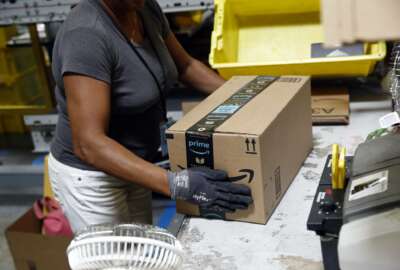

The department announced a beta platform called Lighthouse Lab for developers to access tools for creating mobile and web applications.
The use of Other Transaction Authority (OTA) may be getting a lot of attention across the federal community as a way to address the shortcomings of the Federal Acquisition Regulations, but the Veterans Affairs Department may have found a better way that doesn’t raise as many red flags.
VA is one of the first agencies to use the concept of microconsulting to help develop apps.
The department announced a beta platform called Lighthouse Lab for developers to access “tools for creating mobile and web applications that will help Veterans better manage their care, services and benefits.”
VA said the agency plans on developing Lighthouse through a series of small contracts, less than $10,000, which is the current micro-purchase threshold.
As part of the final 2018 Defense Authorization bill, Congress raised the micro-purchase threshold to $10,000, and the Civilian Agency Acquisition Council issued a FAR deviation on Feb. 22 to enable agencies to begin buying at the higher level.
Chris Cairns, a partner at Skylight Digital, and a former Presidential Innovation Fellow and co-founder of the 18F digital services group at the General Services Administration, said this concept of micro-consulting, which Skylight Digital provides to agencies, is growing across the government and private sector.
“With my experience at 18F, we had a lot of clients with different needs, and we couldn’t serve all of them because of the small dollar value, we needed interagency agreements and agencies couldn’t use their credit cards with us, and it was just unwieldy after a while,” Cairns said in an interview. “But there were some case where clients had specific needs that if you just focused on supporting them for a few days or weeks, especially acquisition projects in the pre-award stage where the agency was thinking about crafting the solicitation, it would greatly increase the probability of success. Sometimes clients just need targeted advice. This is a model in general is not something the government uses often.”
Cairns said the increase in the micro-purchase threshold gives agencies a new opportunity to make a bigger impact on its acquisition planning without a huge investment.
“If you are a new vendor in this government space trying to break into the market, this is a great model to get exposure for you and the government,” he said. “You can readily start interacting with government and they can try before they buy.”
This is exactly the same thought process behind OTAs, but the risk with micro-consulting is much less and, as Cairns said, the rules around the micro-purchase threshold are well understood whereas with OTAs, they are not.
Take VA, for example. It plans on starting with an initial user group to help test application programming interfaces (APIs), build out documentation, development governance standards and test developer supported workflows.
“Lighthouse’s architecture supports VA’s move toward adopting commercial off-the-shelf (COTS) products and innovative acquisition approaches, such as micro-purchasing agreements with a $3,500 threshold for technology solutions that can be rapidly deployed to Veterans,” the VA said in a release.
Cairns said this approach presents a much lower risk, and there is plenty of well-established regulations and understanding of how the micro-purchase threshold works in government.
“This is a safer approach to experimenting and getting to different types of providers,” he said. “VA probably has specific use cases in mind that are consumer oriented and targeted to the veteran audience.”
On the Lighthouse Lab Github page, VA says the platform is about bringing revolutionary changes to veterans’ healthcare.
“We need even smarter communication tools, information systems, patient-facing applications and predictive analytics. We also need to foster a culture and environment that attracts inventive companies and developers that can build even better solutions going forward. This kind of innovative ecosystem requires a digital platform strategy leveraging open application programming interfaces (APIs) to fully support healthcare interoperability and the next generation of care for Veterans,” the agency stated. “The central nervous system to VA’s digital transformation strategy is leveraging a strategic open API program called Lighthouse that adopts an outside-in, value-to-business driven approach to create API’s that are managed as products to be consumed by developers internal and external to VA. Such an approach serves as a change catalyst that will allow VA to decouple systems and continue to leverage its investment in various digital assets, support application rationalization and allow it to absorb new, commercial software-as-a-solution (SaaS) to replace homegrown, outdated systems. This strategy calls for a clearly defined operating model for managing the complete life cycle of API’s and will include the planning, design, implementation, publication, maintenance, and retirement of APIs as well the operation of the API Gateway platform on a VA private cloud.”
VA Secretary David Shulkin took this commitment to open APIs even further on Friday by pledging that the agency “will provide API access to developers for Veteran-designated mobile and web-based apps, clinician-designated applications for those who serve them and Choice Act partners responsible for coordinating their care via ‘bulk’ access.”
In the past, VA maintained closed systems, which made it more difficult to bring in new technologies.
By setting up Lighthouse Lab, VA said its following industry best practices through a flexible and reusable framework.
“This will provide our organization with a foundation where resources can come together — sometimes very quickly and temporarily, sometimes in a relatively fixed way — to create value. Some resources may be inside, permanently owned by the organization; some will be shared; and some can come from outside. The value largely comes from connecting the resources, and the network effects between them,” VA stated. “We will also be able to effectively shift technology development to commercial electronic health record (EHR) and administrative systems vendors that can integrate modular components into the enterprise through open API’s. This will allow VA to leverage these capabilities to adopt more efficient and effective care management processes while fostering an interoperable, active, and innovative ecosystem of solutions and services through its open API framework. This will enable the next generation of healthy living and care models that are more precise, personalized, outcome-based, evidence-based, tiered and connected across the continuum of care regardless of where and how care is delivered. This API-enabled, open and accessible platform can be used not only for veterans’ care but also for advanced knowledge sharing, clinical decision support, technical expertise, and process interoperability with organizations throughout the U.S. care delivery system.”
VA is holding a lot of hope in the promise of open APIs through Lighthouse Lab, and at least if they use the micro-consulting approach, it is keeping its risk low and potential reward high.
Copyright © 2025 Federal News Network. All rights reserved. This website is not intended for users located within the European Economic Area.
Jason Miller is executive editor of Federal News Network and directs news coverage on the people, policy and programs of the federal government.
Follow @jmillerWFED


